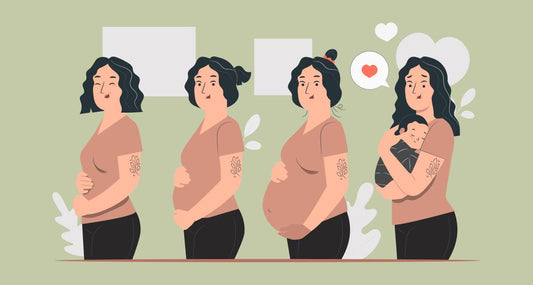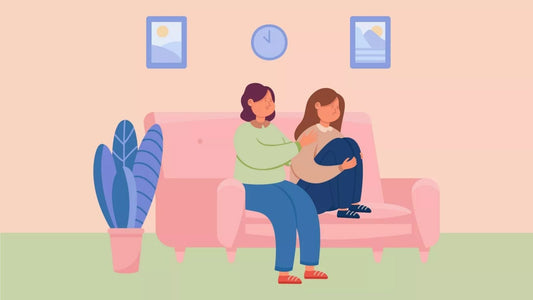What to Expect in the First, Second, and Third Trimesters
Pregnancy is a journey marked by incredible changes, each trimester bringing its own unique set of experiences and transformations. As you prepare to welcome your baby, it's important to understand what each stage entails. Let's delve into the first, second, and third trimesters, exploring the details, symptoms, and what to expect month by month.

First Trimester: The Beginning of a New Life
The first trimester spans from conception to 12 weeks and is a time of rapid development and significant changes. This period can be both exciting and challenging as your body begins to adjust to pregnancy.
Month 1 (Weeks 1-4)
At the moment of conception, a unique combination of genetics comes together to form a new life. During the first few weeks, you might not even realize you're pregnant. The fertilized egg travels down the fallopian tube and implants itself in the uterine lining, where it begins to grow.
- Symptoms: Some early signs of pregnancy include missed periods, light spotting, fatigue, and tender breasts. You might also experience mild cramping, which is normal as your body starts to change.
Month 2 (Weeks 5-8)
By the second month, the embryo is growing rapidly. Its major organs and systems begin to form, including the brain, heart, and spinal cord. The placenta, which will nourish your baby throughout pregnancy, also starts to develop.
- Symptoms: Morning sickness, characterized by nausea and sometimes vomiting, often begins during this time. You might also notice increased fatigue, frequent urination, and heightened sensitivity to smells. It's common to experience emotional swings due to hormonal changes.
Month 3 (Weeks 9-12)
As you approach the end of the first trimester, the embryo graduates to become a fetus. By the end of the 12th week, the baby has developed most of its major organs, and it’s about the size of a lime.
- Symptoms: Morning sickness and fatigue might continue, but you may also notice changes in your skin, such as increased oiliness or pigmentation. Some people also experience mood swings and increased appetite.

Second Trimester: The Glow of Pregnancy
The second trimester, spanning weeks 13 to 26, is often considered the best part of pregnancy. Many uncomfortable early symptoms subside, and you'll likely start to feel more energized. This is also when your baby begins to move, making the pregnancy feel more real.
Month 4 (Weeks 13-16)
Entering the second trimester, your baby is growing quickly. Their organs continue to mature, and bones start to harden. Around this time, the baby’s movements may become noticeable, often described as fluttering sensations known as quickening.
- Symptoms: You may find relief from morning sickness, and your energy levels could increase. However, you might start experiencing back pain and round ligament pain as your uterus expands.
Month 5 (Weeks 17-20)
By the fifth month, you’ll likely start to show more prominently. Your baby is now about the size of a bell pepper and continues to develop fine details like fingerprints and hair. You might have your mid-pregnancy ultrasound during this time, offering a clearer look at your baby.
- Symptoms: In addition to feeling your baby’s movements, you might experience heartburn, leg cramps, and swollen gums. It’s also common to deal with nasal congestion due to increased blood flow.
Month 6 (Weeks 21-24)
During the sixth month, your baby continues to grow and develop. Their lungs are forming air sacs, and they’re practicing breathing movements. Around this time, the baby can also respond to sounds and may even start to recognize your voice.
- Symptoms: You may experience Braxton Hicks contractions, which are irregular and usually painless. Other symptoms include backaches, stretch marks, and skin changes like dark patches.
Month 7 (Weeks 25-28)
As you near the end of the second trimester, your baby is becoming more active, with stronger and more frequent movements. Their brain is developing quickly, and they’re starting to gain more body fat.
- Symptoms: You might find it harder to sleep comfortably and may experience more pronounced swelling in your feet and ankles. Some people also notice varicose veins and hemorrhoids due to increased blood volume and pressure.

Third Trimester: The Final Countdown
The third trimester, from weeks 27 to 40, is the home stretch of your pregnancy journey. This period is marked by significant growth and preparation for birth.
Month 7 (Weeks 25-28)
Your baby continues to grow and gain weight, becoming stronger and more active. They can now open and close their eyes, and their bones are fully developed, though still soft.
- Symptoms: Physical discomfort is common as your body prepares for childbirth. You might experience shortness of breath, difficulty sleeping, and more frequent Braxton Hicks contractions.
Month 8 (Weeks 29-32)
By the eighth month, your baby’s movements may start to feel more like kicks and rolls. Their brain development is intense, and they’re continuing to store body fat. The baby’s position in the womb may shift downward in preparation for birth.
- Symptoms: You’re likely feeling quite large and may experience increased back pain, pelvic pressure, and swelling. Sleep may become even more challenging, and heartburn could persist.
Month 9 (Weeks 33-36)
As you reach the final stretch, your baby is almost ready to meet the world. They’re continuing to grow and gain weight, and most of their major development is complete. Your baby’s movements might slow down slightly as they run out of room to move.
- Symptoms: The discomforts of pregnancy can be pronounced at this stage. You might feel increased pelvic pain, difficulty walking, and continued Braxton Hicks contractions. You may also notice your baby “dropping” lower in your abdomen as they prepare for birth.
Month 10 (Weeks 37-40)
Technically, pregnancy is 40 weeks long, which means the 10th month is included in the third trimester. Your baby is considered full-term at 37 weeks and could arrive any day now.
- Symptoms: You’re likely experiencing maximum physical discomfort, including pelvic pressure, difficulty sleeping, and frequent urination. You might also notice an increase in vaginal discharge, mucus plug release, and stronger, more regular contractions indicating labor.

What to Expect Each Trimester
Now that we've covered the general timeline, let's dive deeper into what you can expect in each trimester, focusing on key symptoms, changes, and tips to make this journey smoother.
First Trimester: Key Changes and Tips
- Hormonal Shifts: Expect significant hormonal changes that affect both your body and emotions. The hormone progesterone increases to support your pregnancy, but it can also lead to fatigue and mood swings.
- Physical Changes: Your breasts might become tender, and you could experience bloating and constipation due to hormonal changes.
- Emotional Well-being: Mood swings are common, and it’s important to find ways to manage stress. Connecting with a supportive community or practicing relaxation techniques can help.
Second Trimester: Key Changes and Tips
- Growing Belly: Your abdomen will expand as the baby grows, which can lead to skin stretching and potential discomfort.
- Increased Energy: Many expectant parents feel a boost in energy during this trimester, making it an excellent time to prepare for the baby’s arrival.
- Bonding with Baby: Feeling your baby move can be an incredibly bonding experience. Talk to your baby, play music, and savor these moments of connection.
Third Trimester: Key Changes and Tips
- Preparation for Birth: As your body prepares for labor, you might experience more frequent and stronger Braxton Hicks contractions. It’s essential to differentiate these from true labor contractions, which are more regular and painful.
- Physical Discomfort: Back pain, pelvic pressure, and difficulty sleeping are common. Using pregnancy pillows and practicing gentle exercises can alleviate some discomfort.
- Mental Preparation: The anticipation of labor and parenthood can lead to anxiety. Preparing a birth plan and discussing your preferences with your healthcare provider can provide peace of mind.

The Role of a Doula in Each Trimester
As a doula, I'm here to support you through every stage of your pregnancy. Here's how I can help during each trimester:
First Trimester Support
- Emotional Support: The early weeks of pregnancy can be filled with anxiety and uncertainty. I'm here to listen to your concerns, answer your questions, and provide reassurance.
- Resource Sharing: I can connect you with valuable resources related to prenatal care, nutrition, and mental health, helping you make informed decisions about your pregnancy.
Second Trimester Support
- Education: This is a great time to start learning about childbirth and parenting. I offer prenatal classes and resources to help you prepare for labor, delivery, and beyond.
- Planning: We can start discussing your birth preferences and creating a birth plan that reflects your desires and values.
Third Trimester Support
- Birth Preparation: As you approach labor, I’ll provide guidance on recognizing the signs of labor, when to call your healthcare provider, and what to expect during delivery.
- Physical Comfort: Techniques such as belly binding, bodywork, and massage can help alleviate discomfort and prepare your body for birth.
- Emotional Readiness: Together, we’ll work on managing any anxieties you may have about labor and parenthood, ensuring you feel confident and supported.

Transitioning to Postpartum
The journey doesn't end with childbirth. The postpartum period, often referred to as the "fourth trimester," is just as important. Here’s what to expect:
Physical Recovery: Your body will go through many changes as it heals from childbirth. From managing postpartum bleeding to dealing with sore muscles, it’s crucial to take it easy and allow time for recovery.
Emotional Adjustments: Hormonal shifts, sleep deprivation, and the demands of caring for a newborn can lead to a rollercoaster of emotions. It's normal to feel overwhelmed, but don’t hesitate to seek support from loved ones or professionals if you need it.
Bonding with Baby: This is a precious time to connect with your baby. Skin-to-skin contact, breastfeeding, and simply spending time together can strengthen your bond.
Support Systems: As your postpartum doula, I provide support to help you navigate this period. From breastfeeding guidance to practical assistance with newborn care, my goal is to make this transition as smooth as possible.

FAQs
- What should I expect in the first trimester of pregnancy? The first trimester is a period of rapid development and significant hormonal changes. You may experience symptoms like morning sickness, fatigue, and mood swings. It's important to rest, eat well, and seek support when needed.
- How can I manage discomfort during the second trimester? As your energy levels increase, it’s a good time to engage in light physical activity and connect with other expectant parents. Using supportive pillows for sleep and practicing relaxation techniques can also help alleviate discomfort.
- What are common third-trimester symptoms, and how can I cope with them? Common symptoms include back pain, pelvic pressure, and frequent urination. Practicing gentle exercises, using pregnancy pillows, and maintaining good posture can help. It’s also important to stay hydrated and rest as much as possible.
- How can a doula support me throughout my pregnancy? A doula offers emotional support, educational resources, and practical assistance at every stage of your pregnancy. From creating a birth plan to providing comfort measures during labor, a doula ensures that you feel supported and informed.
- What should I focus on in the postpartum period? The postpartum period is a time of physical recovery and emotional adjustment. Focus on rest, bonding with your baby, and seeking support from loved ones and professionals. Don’t hesitate to ask for help when you need it.
For comprehensive support throughout your pregnancy and beyond, visit my services page for more information about how I can assist you on this incredible journey.







0 comments